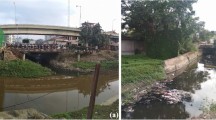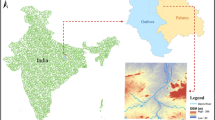Abstract
In South Africa, wetlands are highly regarded for the treatment of mine-water pollution in gold mine areas of the Witwatersrand basin for over a century. The current work addresses the role of small wetlands developed around micro-dams that are used for recreational purpose around the city of Johannesburg. Integrated monitoring program was developed that includes physico-chemical, chemical, biological oxygen demand (BOD5) and microbial determination. Based on the monitoring results, the overall removal efficiency of the wetlands were about 60 % for BOD5 and 76 to 100 % for microbial count. Comparative analysis of BOD5 in the micro-dams and piezometers resulted in the decrease in concentration in the range of 70 to 83 %, which indicates an important role of sediments in the attenuation process. Observational evidences suggest that wetlands play a paramount role in the maintenance of water quality in the micro-dams, which is destined for different environmental uses in Johannesburg, South Africa.





Similar content being viewed by others
References
Abiye T (2014) Mine water footprint in the Johannesburg area, South Africa: analysis based on existing and measured data. South African Journal of Geology 117(1):87–96
American Groundwater Trust (1998) Bacteria and water wells. Consumer awareness information pamphlet. Number 10: p1–15
Birch GF, Mathhai C, Fazeli MS, Yul Suh J (2004) Efficiency of a constructed wetland in removing contaminants from stormwater. Wetlands 24:459–466
Boutilier L, Jamieson R, Gordon R, Lake C, Hart W (2010) Performance of surface flow domestic wastewater treatment wetlands. Wetlands 30:795–804
Brix H (1997) Do macrophytes play a role in constructed treatment wetlands? Water Science and Technology 35:11–17
Collins NB (2005) Wetlands: the basic and some more. Free state Department of Tourism, Environment and Economic Affairs. Bloemfontein, South Africa
Frimmel HE, Minter WEL (2002) Recent developments concerning the geological history and genesis of the Witwatersrand gold deposits, South Africa. Society of Economic Geologists (Special Publication) 9:17–45
Garfi M, Pedescoll A, Becares E, Valsero MH, Cardona RS, García J (2012) Effect of climatic conditions, season and wastewater quality on contaminant removal efficiency of two experimental constructed wetlands in different regions of Spain. Science of the Total Environment 437:61–67
Hamaamin YA, Adhikari V, Pouyan Nejadhashemi A, Harrigan T, Reinhold DM (2014) Modelling E. Coli removal in constructed wetlands under pulse loading. Water Research 50:441–454
Hemond HF, Benoit J (1988) Cumulative impacts on water quality functions of wetlands. Environmental Management 12(5):639–653
Hong-Bo S, Bao-Shan C, Jun-Hong B (2012) Wetland ecology in China. Clean: Soil, Air, Water 40(10):1011–1014
Kadlec RH, Knight RL (1996) Treatment wetlands. Lewis publishers, New York
Kaplan D, Bachelin M, Carpena RM, Chacón WR (2011) hydrological importance and water quality treatment potential of a small freshwater wetland in the humid tropics of Costa Rica. Wetlands 31:1117–1130
Kivaisi AK (2001) The potential for constructed wetlands for wastewater treatment and reuse in developing countries: a review. Ecological Engineering 16:454–566
Li X, Mander Ü, Ma Z, Jia Y (2009) Water quality problems and potential for wetlands as treatment systems in the Yangtze River Delta. Wetlands 29:1125–1132
Maclntyre ME, Warner BG, Slawson RM (2006) Escherichia coli control in a surface flow treatment wetland. Journal of Water and Health 04(2):211–214
Masetle L (2013) Ecological integrity of Westdene and Emmarentia dams in Johannesburg. Unpublished mini MSc Thesis, University of Johannesburg, p 82
Merlin G, Pajean J, Lissolo T (2002) Performances of constructed wetlands for municipal wastewater treatment in rural mountainous area. Hydrobiologia 469:87–98
Ngigi SM (2009) Establishing effective, appropriate and applicable technologies in treating contaminate surface water as part of a rehabilitation strategy for the Princess dump in Roodeport, West of Johannesburg. MSc research report (unpubl). University of the Witwatersrand, Johannesburg, 81
Nivala J, Wallace S, Headly T, Kassa K, Brix H, van Afferden M, Muller R (2013) Oxygen transfer and consumption in subsurface flow treatment wetlands. Ecological Engineering 61P:544–554
Shutes RBE (2001) Artificial wetland and water quality improvement. Environment International 26:441–447
Tu YT, Chiang PC, Yang J, Chen SH, Kao CM (2014) Application of a constructed wetland system for polluted stream remediation. Journal of Hydrology 510:70–78
Venter A (2007) Prioritization of river basins in the Tshwane area with reference to faecal coliform bacteria for the purpose of the identification of candidate wetlands for rehabilitation. MSc research report (unpublished). University of the Witwatersrand, Johannesburg, 112 pp
Verhoeven JTA, Meuleman AFM (1999) Wetland for wastewater treatment: opportunities and limitations. Ecological Engineering 12:5–12
Weerakoon GMPR, Jinadasa KBSN, Herath GBB, Mowjood MIM, van Bruggen JAA (2013) Impact of the hydraulic loading rate on pollutants removal in tropical horizontal subsurface flow constructed wetlands. Ecological Engineering 61:154–160
Wu H, Zhang J, Li C, Fan J, Zou Y (2013) Mass balance study on phosphorus removal in constructed wetland microcosms treating polluted river water. Clean: Soil, Air, Water 41(9):844–850
Acknowledgments
The author would like to thank the participation of Honours students particularly I. Mogatusi, M. Setladi and T. Ramsaroop during the field and laboratory based data collection and analyses.
Author information
Authors and Affiliations
Corresponding author
Rights and permissions
About this article
Cite this article
Abiye, T. The Role of Wetlands Associated to Urban Micro-Dams in Pollution Attenuation, Johannesburg, South Africa. Wetlands 35, 1127–1136 (2015). https://doi.org/10.1007/s13157-015-0700-0
Received:
Accepted:
Published:
Issue Date:
DOI: https://doi.org/10.1007/s13157-015-0700-0




